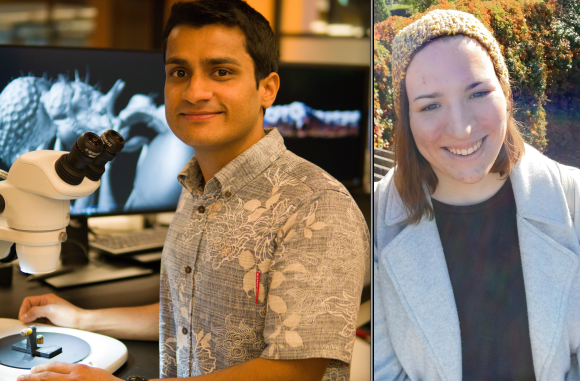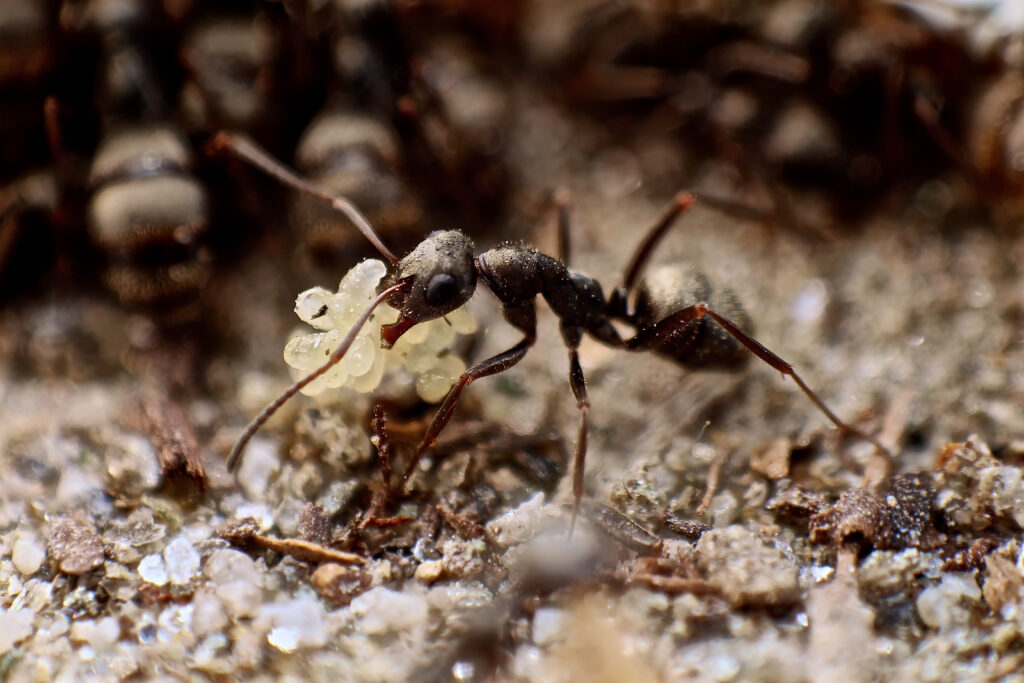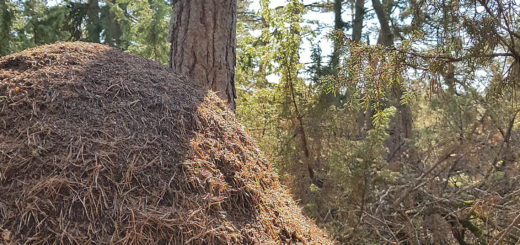The supergene wave is well underway
In the recent review “Supergenes as drivers of ant evolution” published in Myrmecological News, Michel Chapuisat focuses on the social structure of ant colonies, which can comprise one or multiple queens. It was previously thought that this variation was due to environmental and social factors, but research has shown that it can also be caused by “supergenes,” large groups of linked genes that control complex adaptive traits. Here, Waring “Buck” Trible highlights the main points of this review.

A Review by Waring “Buck” Trible, John Harvard Distinguished Science Fellow, Harvard University
Edited by: Gaurav Agavekar and Beatriz Portinha

This month, Michel Chapuisat provides an excellent and timely overview of ant supergenes. Chapuisat is a great person to write this review, having been on the scene since Ken Ross’s first report, in 1992, of genetic regulation of ant colony organization1. Those early results, which regarded an allelic variant correlated with queen number in fire ant colonies, have been expanded and deepened in further studies of the fire ants. Critically, similar polymorphisms have now been discovered in unrelated ant species.
Here’s the status of the field in a nutshell: lots of ant populations are polymorphic for ‘social chromosomes’, or supergenes, that have a more-than-passing resemblance to sex chromosomes2. Instead of regulating whether an individual will develop into a male or female, these large, non-recombining genetic elements regulate features of social organization, like whether an ant colony will have one queen (monogyny) or hundreds of queens (polygyny). Consequently, these phenotypes vary in these species according to simple patterns following Mendel’s laws of inheritance, rather than varying via many genetic loci, as is typically expected for such complex traits. Chapuisat’s useful review covers many topics someone interested in ant supergenes would want to know about: the history of the field, key discoveries, tips for supergene hunting, and future prospects. As this once-obscure subdiscipline grows into a cornerstone of modern ant research, this review will refresh the memory of established myrmecologists and help orient young researchers.
When I started my PhD in 2013, twenty-plus years after Ken’s initial report, I used to joke that scientists had discovered fewer total Mendelian elements across all of the ants than Gregor Mendel had found in pea plants by the time he published his original 1866 paper. This lag arose because, unlike peas, it is impractical to perform controlled laboratory crosses in the overwhelming majority of ant species. This meant that the discovery of a Mendelian element required the blind luck of finding a genetic marker that correlates with a phenotype (Ross’s fire ant allozyme) or working with one of the small number of ant species that can be mated in captivity (Winter, Buschinger, and Heinze’s E elements of Leptothoracines)3–5.
This issue has since been resolved with technology: using whole-genome resequencing, we can test whether any polymorphism in an ant genome segregates with any phenotype of interest, and many researchers are now doing just that. Starting with Purcell & colleagues’ discovery in 2014 that Formica ants display genetic regulation in colony queen number, we’re off to the races: myrmecologists have reported at least five independent supergenes controlling colony queen number6. Last year, Brelsford, Purcell, and colleagues found the first supergene for something other than queen number: a bizarre element that regulates whether a colony produces queen or male alates –acting as a sex chromosome, but for a colony rather than an individual7. This is the tip of the iceberg, and many more ant supergenes will be reported in the next few years. It took a hundred fifty years, but myrmecologists can now give Mendel a run for his money. Bested by a monk NO MORE!
As I close this blog post, I would like to encourage the reader to think about where this is all going. We’re all well aware that the described species of ants show vibrant (maybe even unmatched) phenotypic diversity, including variation in diet, ecology, morphology, behavior, and many other traits. Why did ants explode like this? The received wisdom is that this adaptive radiation was a consequence of eusociality: colony life opens up new opportunities, culminating in ‘the social conquest of earth’8. That might be true. But, even just for a moment, would you be willing to consider that it has less to do with eusociality and more to do with genetics? As Chapuisat points out, the genetic details of these supergenes (such as selfish drive and overdominance) have major implications for their stability and evolution. For instance, the supergene that induces polygyny in fire ants is recessive lethal: queens that bear a single copy of the supergene, termed ‘Sb’, display the polygyne phenotype, but queens with two copies invariably die. In genetic terms, SB/SB queens are monogyne, SB/Sb queens are polygyne, and Sb/Sb queens are dead. This means that it’s not possible for monogyne ants to go extinct (the SB allele is required for the viability of polygyne queens, so it can never go to a 0% frequency). Thus, we don’t need to go looking for a reason why the polygyne phenotype never goes to fixation in these fire ants: it can’t. As a community, I hope that the lesson from this observation will sink in: if we try to explain a phenotypic variant before we learn about its genetic underpinnings, we might come to incorrect conclusions about its evolution.
I’m not saying I believe it, but could this supergene story be true writ-large? Is it possible that something unusual about the way ants perform their meioses or inherit their chromosomes, or even hybridize, generates these sex-chromosome-like supergenes that then drive radical phenotypic variation? After all, ants do in fact show the largest diversity in chromosome number of any animal group9. Maybe something unusual in their genetics could even explain how ants became eusocial in the first place? I was intrigued when, in eusocial bees, newly-mapped Mendelian elements turned out to be small loci rather than chromosome-length supergenes10,11. Could it be that we can’t actually explain why ants possess so much phenotypic diversity until we understand their unorthodox genetic systems? Maybe songwriter Osvaldo Farrés was already pondering supergenes in 1947: quizás, quizás, quizás.
References
1. Ross, K.G. 1992: Strong selection on a gene that influences reproductive competition in a social insect. – Nature 359, 150–152.
2. Wang, J., Wurm, Y., Nipitwattanaphon, M., Riba-Grognuz, O., Huang, Y.C., Shoemaker, D., and Keller, L. 2013: A Y-like social chromosome causes alternative colony organization in fire ants. – Nature 493, 664–668.
3. Gotzek, D., and Ross, K.G. 2007: Genetic regulation of social organization in fire ants: an integrative overview. – Q. Rev. Biol. 82, 201–226.
4. Winter, U., and Buschinger, A. 1986: Genetically mediated queen polymorphism and caste determination in the slave-making ant, Harpagoxenus sublaevis (Hymenoptera: Formicidae). – Entomol. Gen. 11, 125–137.
5. Heinze, J., and Buschinger, A. 1987: Queen polymorphism in a non-parasitic Leptothorax species (Hymenoptera, Formicidae). – Insectes Soc. 34, 28–43.
6. Purcell, J., Brelsford, A., Wurm, Y., Perrin, N., and Chapuisat, M. 2014: Convergent genetic architecture underlies social organization in ants. – Curr. Biol. 24, 2728–2732.
7. Lagunas-robles, G., Purcell, J., and Brelsford, A. 2021: Linked supergenes underlie split sex ratio and social organization in an ant. Proc. Nat. Acad. Sci. 46, e2101427118.
8. Wilson, E.O. 2012: The social conquest of earth (VW Norton & Company).
9. Lorite, P., and Palomeque, T. (2010: Karyotype evolution in ants (Hymenoptera: Formicidae), with a review of the known ant chromosome numbers. – Myrm. News 13, 89–102.
10. Yagound, B., et al. 2020: A single gene causes thelytokous parthenogenesis, the defining feature of the Cape honeybee Apis mellifera capensis. – Curr. Biol. 30, 1–12.
11. Kocher, S.D., Mallarino, R., Rubin, B.E., Douglas, W.Y., Hoekstra, H.E., and Pierce, N.E. 2018: The genetic basis of a social polymorphism in halictid bees. – Nat. Commun. 9, 1-7.






These are interesting thoughts of Waring „Buck“ Trible. Since our early papers on queen polymorphism 1), 2) are cited, I may refer to a couple more papers on genetically controlled queen polymorphism:
Heinze & Buschinger 1987 was followed by 3), the experimental proof of a genetic origin of queen polymorphism by crossbreeding. The species in question, „Leptothorax sp. A“, is one of several Leptothorax species in North America, belonging to a L. muscorum-complex which still needs taxonomic clarification.
Queen polymorphism with both gynomorphs and intermorphs further has been found in two Australian Monomorium species. Monomorium cf. leae (identified by Brian Heterick) and provisionally named Monomorium sp. 10, has been studied in the Australian Alps at higher elevations 4). Monomorium cf. rubriceps 5) also has been reared in the lab. Though sexuals of both species did not mate in laboratory conditions the offspring of field-collected queens indicates a genetical basis of queen polymorphism at least in Monomorium sp. 10.
Finally, Myrmecina graminicola from Germany exhibits queen polymorphism with both gynomorphic and intermorphic queens 5), 6), 7), 8). Crossmatings were possible as in H. sublaevis and Leptothorax sp. A. Most interesting in this species is a behavioral difference correlated with queen morph: Colonies with dealate (gynomorphic) queens are always monogynous, whereas colonies with intermorphs are usually polygynous with several mated and egg-laying specimens.
Myrmecina graminicola therefore might be most promising for molecular studies of the genetic background of both queen morph and behavior. The species is fairly common in central Europe, and the small colonies can be completely collected in the field.
A supergene, or a single gene that controls the expression of a series of subsequent developmental genes?
References:
1) Winter, U., and Buschinger, A. 1986: Genetically mediated queen polymorphism and caste determination in the slave-making ant, Harpagoxenus sublaevis (Hymenoptera: Formicidae). – Entomol. Gen. 11, 125–137.
2) Heinze, J., and Buschinger, A. 1987: Queen polymorphism in a non-parasitic Leptothorax species (Hymenoptera, Formicidae). – Insectes Soc. 34, 28–43.
3) Heinze, J., Buschinger, A. 1989: Queen polymorphism in Leptothorax spec. A.: its genetic and ecological background (Hymenoptera: Formicidae). Insectes Sociaux 36, 139-155.
4) Fersch, R., Buschinger, A., Heinze, J. 2000: Queen polymorphism in the Australian ant Monomorium sp. 10. Insectes soc. 47, 280-284.
5) Buschinger, A., Schreiber, M. 2002: Queen polymorphism and queen-morph related facultative polygyny in the ant, Myrmecina graminicola (Hymenoptera, Formicidae). Insectes soc. 49, 344-353.
6) Buschinger, A. 2011: Queen polymorphism in an Australian ant, Monomorium cf. rubriceps Mayr, 1876 (Hymenoptera: Formicidae). – Myrmecological News 15: 63-66. https://myrmecologicalnews.org/cms/index.php?option=com_content&view=category&id=483&Itemid=359
7) Buschinger, A. 2005: Experimental Evidence for Genetically Mediated Queen Polymorphism in the Ant species Myrmecina graminicola (Hymenoptera: Formicidae). Entomol Gener 27: 185-200. https://www.antwiki.org/wiki/images/8/8d/Buschinger_2005_Myrmecina_gram._Ent._Gen.pdf
8) Buschinger, A., Schlick-Steiner, B. C., Steiner, F.M., Espadaler, X. 2003: On the geographic distribution of queen polymorphism in Myrmecina graminicola (Hymenoptera: Formicidae). Myrmecol. Nachrichten 5, 37-41.